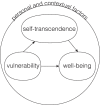A Review on Research and Evaluation Methods for Investigating Self-Transcendence
- PMID: 33312147
- PMCID: PMC7701337
- DOI: 10.3389/fpsyg.2020.547687
A Review on Research and Evaluation Methods for Investigating Self-Transcendence
Erratum in
-
Corrigendum: A Review on Research and Evaluation Methods for Investigating Self-Transcendence.Front Psychol. 2021 Apr 19;12:682099. doi: 10.3389/fpsyg.2021.682099. eCollection 2021. Front Psychol. 2021. PMID: 33953691 Free PMC article.
Abstract
Self-transcendence has been characterized as a decrease in self-saliency (ego disillusionment) and increased connection, and has been growing in research interest in the past decade. Several measures have been developed and published with some degree of psychometric validity and reliability. However, to date, there has been no review systematically describing, contrasting, and evaluating the different methodological approaches toward measuring self-transcendence including questionnaires, neurological and physiological measures, and qualitative methods. To address this gap, we conducted a review to describe existing methods of measuring self-transcendence, evaluate the strengths and weaknesses of these methods, and discuss research avenues to advance assessment of self-transcendence, including recommendations for suitability of methods given research contexts.
Keywords: emotional experiences; flow; mindfulness; neurophenomenolgy; peak experiences; research methods; review; self-transcendence.
Copyright © 2020 Kitson, Chirico, Gaggioli and Riecke.
Figures




References
-
- Abuhamdeh S., Csikszentmihalyi M. (2012). Attentional involvement and intrinsic motivation. Motivat. Emot. 36, 257–267. 10.1007/s11031-011-9252-7 - DOI
-
- Akyalcin E., Greenway P., Milne L. (2008). Measuring transcendence: extracting core constructs. J. Transpers. Psychol. 40, 41–59.
Publication types
LinkOut - more resources
Full Text Sources
Miscellaneous

